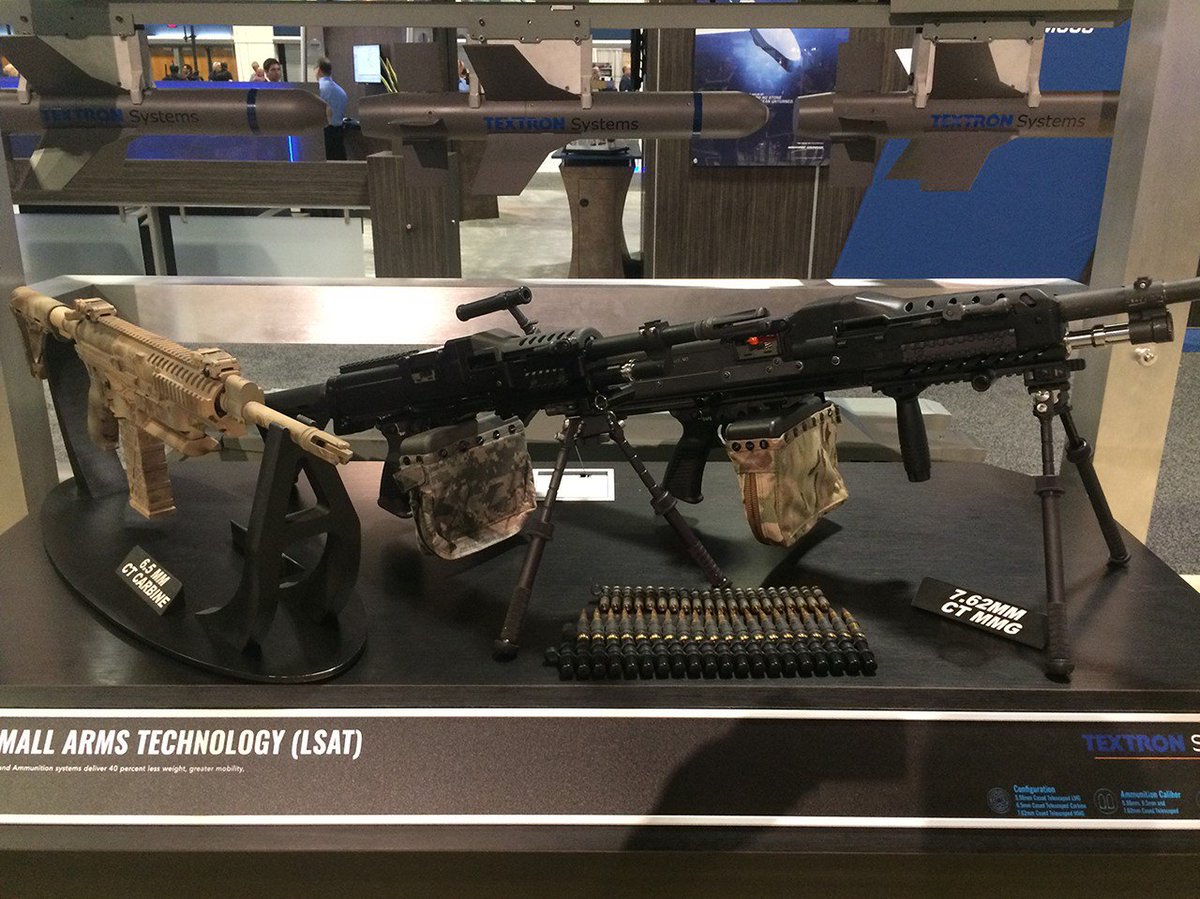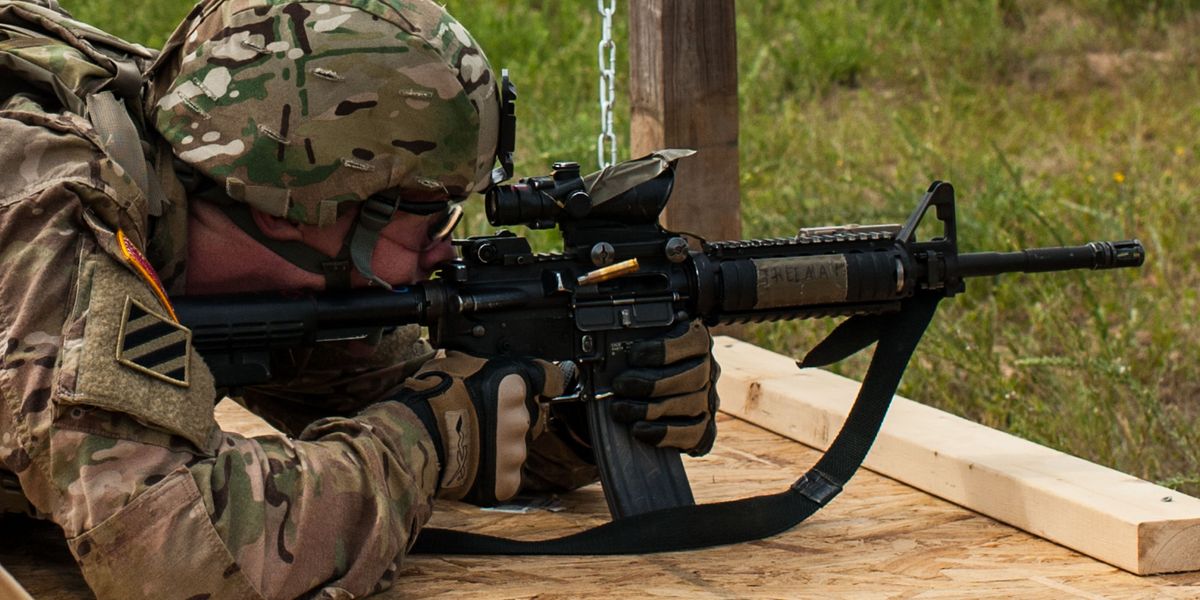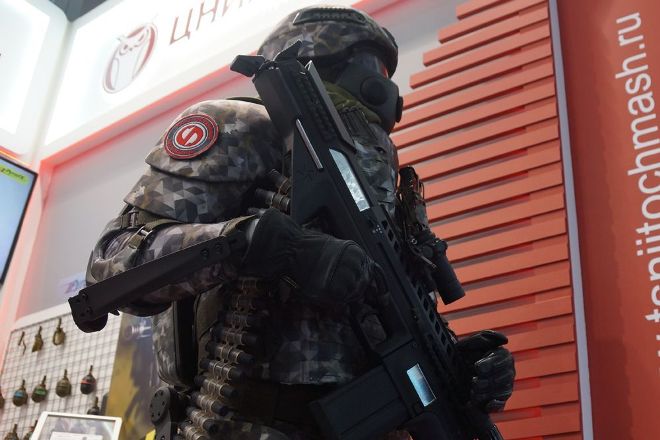Looking at the photo and thinking about it, you could be right. CT ammo would rewrite the rules about how a bullet goes from case to barrel.
CT Ammo Update
Collapse
X
-
Latest info via Tony Williams
Cartridge
Bullet weight: 125 grains (8 grams)
Muzzle velocity: 2,800 fps (850 m/s)
Cartridge weight: 240 grains (15.6 g)
Cartridge dimensions: 0.5" (12.7mm) diameter x 2" (51mm) length
Carbine
Empty weight 8.7 lbs / 3.95 kg (heavy barrel), or <8 lbs / <3.6 kg (standard barrel)
Loaded 20-round magazine: 1 lb / 0.5 kg
Barrel length (excluding chamber): 14.5" / 370 mm (equivalent to 16.5")
Overall length (stock retracted): 32" / 813 mm
Operation: gas piston, rising chamber
Firing rate: 600 rpm
 Info from Textron concerning the 6.5mm CTSAS: bullet weight: 125 grains (8 grams) MV: 2,800 fps (850 m/s) cartridge weight: 240 grains (15.6 g) dimensions: 0.5" (12.7mm) diam x 2" (51mm) length Data on the Carbine: Empty weight 8.7 lbs / 3.95 kg (heavy barrel), or <8 lbs / <3.6 kg (standard barrel) Loaded 20-round magazine: 1 lb / 0.5 kg Length of barrel (excluding chamber): 14.5" / 370 mm (equivalent to 16.5") Length collpased: 32" / 813 mm Operating mech: gas piston, rising chamber Firing rate : 600 rpm Comments: These figures are obviously a bit rounded as the metric and US measurements aren't all exactly in line (e.g. bullet weight 8.1 g). That bullet weight still looks on the high side for lead-free - and the tracer may be even longer. The MV has dropped from the 3,000 fps originally stated, but the ME is still 2,950 J, which is closer to .260 Rem than 264 USA.
Info from Textron concerning the 6.5mm CTSAS: bullet weight: 125 grains (8 grams) MV: 2,800 fps (850 m/s) cartridge weight: 240 grains (15.6 g) dimensions: 0.5" (12.7mm) diam x 2" (51mm) length Data on the Carbine: Empty weight 8.7 lbs / 3.95 kg (heavy barrel), or <8 lbs / <3.6 kg (standard barrel) Loaded 20-round magazine: 1 lb / 0.5 kg Length of barrel (excluding chamber): 14.5" / 370 mm (equivalent to 16.5") Length collpased: 32" / 813 mm Operating mech: gas piston, rising chamber Firing rate : 600 rpm Comments: These figures are obviously a bit rounded as the metric and US measurements aren't all exactly in line (e.g. bullet weight 8.1 g). That bullet weight still looks on the high side for lead-free - and the tracer may be even longer. The MV has dropped from the 3,000 fps originally stated, but the ME is still 2,950 J, which is closer to .260 Rem than 264 USA.
Comment
-
-
There is a ton of information on the TFB interviews with the program manager.
Many technical details have emerged that are rather interesting, and have potential implications that would turn the entire metallic case industry on its head.
There's a polymer plug up front that the bullet seats in, which seals the breech under pressure. They are seeing better accuracy because it's easier to make a concentric polymer plug than brass, and the projectile is not exposed, so no opportunity for applying force to the side of the projectile during feeding.
The propellant is conventional powder, only highly compressed as close to a solid as possible, which improves performance in both ES and velocity.
She also gives the history and initial vision of the project. There are 3 parts already, with weekly updates.
 Not long after SHOT Show, I got the chance to interview Mrs.Kori Phillips, former program officer for the Army’s Lightweight Small Arms Technologies (LSAT) program, and current program officer for the Cased Telescoped Small Arms Systems (CTSAS) program.We talked at length about both programs, the technology they developed, and the state of lightweight ammunition today.NRA Basic, Pistol, Rifle, Shotgun, RSO
Not long after SHOT Show, I got the chance to interview Mrs.Kori Phillips, former program officer for the Army’s Lightweight Small Arms Technologies (LSAT) program, and current program officer for the Cased Telescoped Small Arms Systems (CTSAS) program.We talked at length about both programs, the technology they developed, and the state of lightweight ammunition today.NRA Basic, Pistol, Rifle, Shotgun, RSO
CCW, CQM, DM, Long Range Rifle Instructor
6.5 Grendel Reloading Handbooks & chamber brushes can be found here:
www.AR15buildbox.com
Comment
-
-
I have read that the LSAT LMG and carbine both use a rising chamber design. I see no reason it couldn't be used in a bullpup. The Steyer ACR was a rising chamber bullpup with cylindrical case-telescoped ammunition.Originally posted by VASCAR2 View PostI'm curious if the CT 6.5 could be put into a Bullpup, it might make an ambidextrous Bullpup to heavy. Neat stuff thanks for posting Stan.
I think the rising chamber design is why the barrel of the LSAT carbine is short compared to an M4. The chamber is separate from the barrel and probably isn't included in the barrel length. The M4's chamber is included in the barrel length because it is part of the barrel.
Anyone have photos of a field stripped LSAT carbine or LMG. I'd love to see that.
ETA: Those TFB interviews are really great, LRRPF52. I haven't finished reading them yet, but this part is interesting:
This is also interesting. It may explain why the 6.5 CT ammo weighs almost as much as 7.62 CT ammo:TFB: You obviously have to have a separate chamber and a separate barrel unit. One thing that might be a negative is that on a revolver you have a gap there, where gas can escape. Do you have that problem, or have you found a solution to that?
KP: For case telescoped, the front of the cartridge actually seals the breech, and the plastic flows into the empty space. It’s sort of a balancing act to let the cartridge expand and flow, but not so much that you can’t get the case out of there. It obturates the chamber just like it would with a brass case.
My takeaway from TFB's Kori Phillips interviews is that the LSAT weapons are technology demonstrators. If the technology is adopted, the final configuration (including things like trade-offs between ammunition weight and performance) will be up to the user community.TFB: Originally, LSAT focused on a 5.56mm weapon, but now the focus with CTSAS appears to be a 6.5mm weapon. How did this change come about? Was it a decision from the Infantry School, or an internal development by CTSAS? Is the 6.5mm now the focus of CTSAS, or a side project?
KP: Based on the success of the original 5.56mm CT system, we were given funding from the Army to pursue a Medium Machine Gun (typically 7.62mm) and a Carbine. The 6.5mm ammunition came about as a result of an optimization study that was done strictly for the CT configuration. Both new weapon systems can be used with either a 7.62mm CT cartridge or the 6.5mm CT cartridge.
* * *
TFB: The 6.5mm CT according to LSAT’s slides weighs 15.4 grams per shot, compared to the 12 grams per shot of brass-cased 5.56mm. In a couple of articles I wrote, I examined the weight penalty of using a round this heavy as a replacement for both 5.56mm and 7.62mm. Does the CTSAS program consider this weight penalty acceptable, or not? If so, is the idea to reduce the number of rounds carried by the infantryman in exchange for greater effectiveness of the individual projectiles, or is the 15.4 grams just the current state of things, the weight of ammunition expected to decrease with development?
KP: Since the 6.5mm is a heavier projectile than the 5.56mm, and it requires more propellant to achieve the necessary velocity, it will probably always be heavier than the 5.56mm round. This is an option that is being offered for a round that provides considerably more range and performance than even the 7.62mm, so that is actually a better comparison. The trade-off between weight and performance is totally up to the user community, and not the technology developer.
Comment
-
-
Originally posted by Essayons View PostI think the rising chamber design is why the barrel of the LSAT carbine is short compared to an M4. It's not short compared to an M4 barrel.
It's not short compared to an M4 barrel.
Excluding chamber, barrel length is 14.5" (same as M4).
Including chamber, barrel length is 16.5" (2" longer than M4).
Comment
-
-
-
Did some research. I believe that AAI has a contract to make an 6.5mm CT round for evaluation.
 Previously, we discussed different concepts for lightening the soldier’s load, including aluminum-, composite-cased and caseless ammunition.Today we’re going to look at the weight-reducing concept that many believe is the horse to bet on when it comes to next-generation small arms ammunition, and that is the plastic-cased telescoped ammunition concept, often referred to as cased, telescoped ammunition (CTA).Where plastic-cased composite ammunition addresses the problem of extracting a polymer cartridge case by incorporating a metallic rim or base, the CTA concept takes a page from the playbook of caseless ammunition and asks the question: Do we really need to be pulling cartridges out of the chamber?Instead, CTA weapons are designed to push spent casings out of the front or side of the chamber, using the incoming round as both extractor and ejector.
Previously, we discussed different concepts for lightening the soldier’s load, including aluminum-, composite-cased and caseless ammunition.Today we’re going to look at the weight-reducing concept that many believe is the horse to bet on when it comes to next-generation small arms ammunition, and that is the plastic-cased telescoped ammunition concept, often referred to as cased, telescoped ammunition (CTA).Where plastic-cased composite ammunition addresses the problem of extracting a polymer cartridge case by incorporating a metallic rim or base, the CTA concept takes a page from the playbook of caseless ammunition and asks the question: Do we really need to be pulling cartridges out of the chamber?Instead, CTA weapons are designed to push spent casings out of the front or side of the chamber, using the incoming round as both extractor and ejector.
https://ndiastorage.blob.core.usgovc...33_Shipley.pdf Very good presentationLast edited by n9nwo; 08-23-2017, 03:56 PM.
Comment
-
-
Comment
-
-
6.5 CT carbine working prototype shown at AUSA earlier this week. https://kitup.military.com/2017/10/lethality.html

Comment
-
-
Here is the article
 The National Defense Industry Association has released the PowerPoint presentations from 2016 Armament Systems Forum, including Kori Phillips’ update on the Cased Telescoped Small Arms Systems (CTSAS) program, which is the successor to the well-known Lightweight Small Arms Technologies program (LSAT).Of special note in the presentation is the program’s decision to explore (and, to an extent, promote) the 6.5mm caliber as a viable option for CT configuration next-generation ammunition.There is quite a lot that could be discussed about this, but I’d like to focus on two pieces of information given to us by the presentation, those being the effective ranges and the weight cited for the 6.5mm CT ammunition, shown by the slides below:
The National Defense Industry Association has released the PowerPoint presentations from 2016 Armament Systems Forum, including Kori Phillips’ update on the Cased Telescoped Small Arms Systems (CTSAS) program, which is the successor to the well-known Lightweight Small Arms Technologies program (LSAT).Of special note in the presentation is the program’s decision to explore (and, to an extent, promote) the 6.5mm caliber as a viable option for CT configuration next-generation ammunition.There is quite a lot that could be discussed about this, but I’d like to focus on two pieces of information given to us by the presentation, those being the effective ranges and the weight cited for the 6.5mm CT ammunition, shown by the slides below:
Comment
-






Comment